|
Forums59
Topics1,059,405
Posts14,319,597
Members144,654
| |
Most Online39,925
Dec 30th, 2023
|
|
 Carp-fishing FAQ & Links (Beginners Info, Glossary, Euro Techniques, etc.)
#3797276
08/10/09 01:51 PM Carp-fishing FAQ & Links (Beginners Info, Glossary, Euro Techniques, etc.)
#3797276
08/10/09 01:51 PM
|
Joined: Jul 2005
Posts: 5,857
Smile-n-Nod
 OP
OP
TFF Celebrity
|
OP

TFF Celebrity
Joined: Jul 2005
Posts: 5,857 |
Carp-fishing Frequently Asked QuestionsFAQs: 1. Do you eat carp? Typically, no. Most people on this forum enjoy catching them for the sport. 2. How can I catch them? Sweet corn kernels and a small hook; see here for details. 3. TBA 4. TBA Here are links to a few topics you might be interested in:
Last edited by Starless; 09/02/10 09:21 PM.
Brett
|
|
 Re: Carp FAQ
[Re: Smile-n-Nod]
#3797279
08/10/09 01:51 PM Re: Carp FAQ
[Re: Smile-n-Nod]
#3797279
08/10/09 01:51 PM
|
Joined: Jul 2005
Posts: 5,857
Smile-n-Nod
 OP
OP
TFF Celebrity
|
OP

TFF Celebrity
Joined: Jul 2005
Posts: 5,857 |
<<Back to Table of Contents>>Starless' Beginning CarpingThere have been a lot of posts lately requesting some advice on how to start carp fishing. That's great! I always love to see that our promotion is paying off and new people are getting into the sport. Read through this article, which should give you a good idea on how to start.
All you really need to start fishing for carp is small hooks (#6 is good) and several cans of whole-kernel sweet corn. Circle hooks and octopus circle hooks seem to work best with sweet corn, but any hook should be effective. I usually use a free-sliding egg sinker as a weight, with a tiny split shot about 12 inches above my hook--sort of like a Carolina rig.
When you first get to your spot, chum the area with a few big handfuls of corn. Throw it out as far as you can (which can be tough if you're facing the wind, easier if it's at your back). Don't worry too much if you can't get it very far from the bank; feeding carp are very happy to come near shore. Once you've chummed, thread a few good, fat kernels onto your hook. I like to push the hook point through the bottom of the kernel (where it was cut from the cob) and out the top. I usually prefer three or four kernels, just enough to cover the hook. Some like to thread it up the line; both are effective. Make sure to leave your hook point exposed.
Cast into the area you've chummed, or just beyond it. If you have more then one pole, you can put them all in the same area, or chum several spots; try one near shore, one a little further out, etc.
Unless you are going to leave your bail open or your reel on free-spool, make SURE your rods are well secured. Even a small, 2- to 3-pound carp has absolutely no trouble yanking a rod into the water in the blink of an eye.
My last trip out I had three carp on; each of them hit so hard that my poles completely doubled over and the fish started screaming off drag before I could even lift the pole to set the hook. Needless to say, if I hadn't weighed the poles down with a heavy tackle bag, they would have been gone before I touched them.
You also want to make sure your drag is set well--about half your line test. If you have 8-pound-test line, fill a gallon milk jug (which weighs about eight pounds when full) about halfway and hook it onto your pole. Then set your drag so that when you lift up your pole, the weight pulls out just enough line to keep the half-full jug on the floor.
You don't have to be that technical about it, but you do need to keep your drag set correctly. Carp have soft mouths, so even if you are only getting small fish, you're likely to pull the hook right out if you try to horse them. Plus, you never know when you'll hook a big carp that can easily snap your line. Besides, the whole reason I fish for carp is the fight. You want to hear that drag scream, right? I know I do. Anyway...
Continue to chum your "swim" now and then with a few more handfuls of corn. If you start getting a pod of fish in, you want to keep enough chum out there to keep them feeding, but not to fill them up.
Dough bait is also good for carp. Dough bait is fairly self explanatory, but there are many kinds. One of the simplest and sometimes most effective dough baits for carp is a Wheaties ball. Take a handful of Wheaties cereal and crush it in your hands; get it wet with some lake water and knead it together until it's a good dough. Be careful with your consistency. You want to make sure the dough bait is firm enough to stay on the hook, but soft enough that you are able to easily set the hook through the dough into the fish's mouth when it runs. Roll the dough into a ball around the hook. If you can manage to roll the dough around the shaft of the hook and leave the point exposed, that sometimes helps with hook ups.
Another good carp bait is an old-fashioned night crawler, but of course with those you're likely to hook just about anything in the lake.
Bring a net, a scale, and a camera!
It is best to weigh a carp while it's in the net; subtract the weight of the empty net to get the weight of the fish. The net supports the fish and you don't have to poke a huge hole in its mouth. Plus, as heavy as carp are, the scale is likely to rip out of their soft mouths anyway.
Hope that helps, and let us know how you do. Good luck!
<<Back to Table of Contents>>
Last edited by Starless; 09/02/10 09:21 PM.
Brett
|
|
 Re: Carp FAQ
[Re: Smile-n-Nod]
#3797282
08/10/09 01:51 PM Re: Carp FAQ
[Re: Smile-n-Nod]
#3797282
08/10/09 01:51 PM
|
Joined: Jul 2005
Posts: 5,857
Smile-n-Nod
 OP
OP
TFF Celebrity
|
OP

TFF Celebrity
Joined: Jul 2005
Posts: 5,857 |
<<Back to Table of Contents>>Glossary of Carp-Fishing TermsAcronymsCarp and Related Fish(See the TPWD web site for more information on Texas freshwater fish species.) - Asian Carps: In the US, this term usually refers to certain carp species that have escaped from catfish farms into public waters, where they threaten native fishes:
- Bighead Carp: Has a large, scaleless head (see here).
- Black Carp: Feeds mainly on snails and mussels (see here).
- Grass Carp: See White Amur.
- Silver Carp: Known for jumping out of the water when threatened (see here).
- White Amur: Occasionally used to control aquatic weeds; often called a grass carp (see here and here).
- Common (European) Carp: Introduced from Europe in the 19th century, this is the most widespread type of carp in Texas; often reach 30 pounds or more (see here). Variants include:
- Ghost Carp, or Ghostie: A cross between a metallic koi and a common carp (see here and here).
- Koi: An ornamental Japanese carp (see here and here).
- Leather Carp: A smooth-skinned carp, though a few scales may be present near the dorsal fin (see here).
- Linear: A smooth-skinned carp with a row of large scales along the lateral line (see here).
- Mirror Carp: A carp with very large, irregular, and patchy scales (see here and here).
- Buffalo: Native to Texas, buffalo are actually suckers, not carp:
- Bigmouth Buffalo: Similar to smallmouth buffalo with a thicker body and a forward-facing mouth (see here).
- Black Buffalo: Closely related to the bigmouth buffalo, the black buffalo is darker and has a more horizontal mouth with thicker lips (see here).
- Smallmouth Buffalo: Most common buffalo in Texas; looks like a gray carp with large black eyes and no barbels (see here).
- Other Carps, Suckers, and Carplike Fish:
- Barbels: Small carp-like fish found in Europe and Central Asia (see here).
- Crucian Carp: A small member of the carp family found in Europe and Asia (see here).
Fish-Related Terms- Barbels: The two whisker-like organs on the upper jaw of a common carp, used to find food in murky water (see here).
- Cloopers: Carp that are feeding on the surface.
- Coarse fish: A UK term for fish species that are not part of the salmon or trout families.
- Curtain: A flap of skin in the mouth of a carp. If the curtain is undamaged, it may indicate that the carp has never been caught before.
- Mudders: Carp that are feeding on the bottom and creating a cloud of mud.
- Rough Fish: A US term for fish species that are not commonly caught for food or sport.
- Shoal: A school of fish.
Tackle and Rigs- Backlead: A small weight clipped onto the line after casting; helps to pin the line to the lakebed so fish are not spooked by bumping into it.
- Bolt Rig: A rig with a heavy, semi-fixed lead designed to automatically hook a carp when the leader tightens.
- Bomb: A large lead, or sinker.
- Chod Rig: A carp rig, similar to the helicopter rig, designed for fishing over gravel (chod).
- Circle Hook: A roundish hook with a point that is bent in at a 90-degree angle toward the shaft.
- Controller: A float used when surface fishing; adds weight for longer casts.
- Death Rig: Any rig that may leave a carp tethered to a lead if the main line breaks. Chod rigs and helicopter rigs are often incorrectly rigged as death rigs due to their "fixed" leads.
- Euro: An adjective referring to European fishing gear, baits, tackle, or techniques.
- Feeder: A plastic cage-like device attached to the line instead of a lead (sinker); groundbait is pressed into or molded around the feeder to attract carp to the hookbait.
- Fixed: Immovable; refers to leads or other tackle that cannot slide along the line and that do not come free when the mainline breaks.
- Float: A bobber, often long and slender, use to aid presentation and bite detection; much more sensitive than red-and-white plastic bobbers.
- Flying backlead: A sliding lead that "flies" backwards along the line (toward the angler) during a cast, or when it contacts the water; see Backlead.
- Greedy Pig Rig: A common name for three or more baits (some say four) on a single hair rig; often attracts the largest, "greediest" fish.
- Hair Rig: A rig with a small length of line (the "hair") extending from the shank of the hook; bait is attached to the hair, leaving the hook fully exposed.
- Hair Stop: Anything used to hold a bait on a hair rig; often a small piece of plastic shaped like a dumbbell.
- Helicopter Rig: A rig with a lead at the end of the line, and a leader extending sideways a few inches above the lead. The leader and bait rotate about the mainline during flight.
- Hooklink: See Leader.
- Hooklength: See Leader.
- Lead: A sinker; a heavy lead weight.
- Leader (UK): A length of heavy line (nominally 30 to 40 ft) between the mainline and swivel; can be used for abrasion resistance or to absorb the shock of casting a heavy weight.
- Leader (US): A short piece of line that is tied between the mainline and the hook; called a hooklink or hooklength in the UK.
- Ledger: A rig designed to be fished on the bottom.
- Line aligner: A short piece of heat shrink tubing that keeps the hook at a slight angle to the leader; helps to turn the hook for a better hookset.
- Method feeder: A wire or plastic cage for use with Method mix or packbait.
- PVA: Polyvinyl Alcohol, a plastic-like material designed to melt in water. Comes in bags, mesh tubing, and string, sometimes with flavors and attractants. Used to present freebies (loose bait) very close to the hookbait.
- Running Rig: A rig which uses a free-sliding lead, so a carp feel no resistance when it sucks in the bait.
- Semi-fixed: A rig that allows a lead to come free from the line if the mainline breaks or the lead is snagged.
- Shock leader: A length of heavy line (nominally 30 to 40 feet) between the mainline and the swivel; can withstand the force of a long cast better than the mainline.
- Sliding Ledger: See Running Rig.
- Snowman Rig: Common name for a rig with two boilies on a hair, one that floats (the pop-up) and one that sinks; resembles a two-part snowman.
- Stringer: Several baits connected by a string of PVA string or tape, to present freebies (loose bait) very close to the hookbait.
- Swan shot: Large split shot.
- Trace: See Leader.
- Waggler: A long, slender float, usually affixed to the mainline at the bottom.
- Zig Rig: A sliding ledger rig with a very long leader; the lead sits on the bottom and the bait floats high in the water column.
Baits- Base Mix: Dry mix used in making boilies; often contains soy flour, semolina, corn meal, and other grains. Mixed with wet ingredients to form a paste or dough that is rolled into balls and boiled.
- Boilie: A round, hard bait, like a ball of dough bait that has been hardened by boiling.
- Chum: Bait (often grain, beans, nuts, or animal feed) that is thrown into the water to attract fish to the hookbait.
- Chum Mixer: A type of pet food sold in the UK. Often used for bait when float fishing.
- Donkey Choker: A very large bait; in particular, a large boilie (the size of golf ball or bigger). Used to target large fish.
- Dough Bait: A catch-all term for soft carp baits, often made with flour, corn meal, cereal, bread, and other grain-based ingredients.
- Floaters: Floating baits.
- Groundbait: See Chum.
- Hemp: Sterilized hemp seed used for chum (ground bait). That's it. Really.
- Hookbait: Bait that is put on a hook, or on the hair of a hair rig.
- HNV: High Nutritional Value; used of baits that are a nutritionally sound.
- Maize: Deer corn, boiled and used as bait.
- The "Method": A technique for catching carp that involves molding a ball of groundbait around a plastic cage (a "feeder") that is attached to the line several inches above the hook. The ball of bait attracts the fish to the area immediately around the hook and promotes competitive feeding.
- Method Mix: A semi-moist ball of bait, used when fishing the "Method" (see The Method).
- Packbait: Similar to a Method mix, often used at paylakes.
- Particles: Grains, beans, or nuts when used as hookbaits or groundbait.
- Paste: See Dough Bait.
- Pellets: Small chunks of manufactured, compressed animal food, normally used as groundbait (chum).
- Pop-up: A floating boilie.
- Ready-Mades: Boilies that are commercially made, rather than home made.
- Shelf-Life: Used of boilies that can be stored at room temperatures for many months.
- Snotty: Thick and sticky (see Tiger Nuts).
- Tiger Nuts: A small, wrinkled nut (actually a tuber) that often makes an excellent carp bait. Before use, they should be soaked in water, boiled, and left to stand to develop a "snotty" texture.
Gear- Bait Spoon: A shovel-like scoop on a long handle that an angler uses to throw loose bait into the water to attract fish.
- Baiting Needle: A small needle with a hook on the end (like a knitting or crochet needle), used to put baits onto the hair of a hair rig.
- Baitrunner: A spinning reel with two drag systems; the main drag is used when fighting the fish, and the baitrunner (secondary) drag keeps slight tension on the line after a fish takes the bait (also called a "bait feeder").
- Bank Stick: A metal or plastic stick that is pushed into the ground and used to support a rod holder or bite alarm.
- Bed Chair: A high-tech cot, used for sleeping during long fishing sessions.
- Beta light: See Isotope.
- Big Pit Reel: A spinning reel which holds a large amounts of line (300 yards or more) for making long casts to reach fish far from shore.
- Bite Alarm: An electronic device that alerts an angler to a bite; the fishing line is laid through a slot and the alarm makes a loud beep when the line moves.
- Bivvy: A tent that is open in the front; allows an angler to quickly leave the tent to fight a fish.
- Bobbin: See Dangler.
- Boilie Stick: See Throwing Stick.
- Brolly: A large umbrella, used as a shelter for camping while fishing.
- Buzzers: See Bite Alarm.
- Carbon: Graphite.
- Carp Net: A very large net, often triangular in shape, with a long handle.
- Carp Rod: Often 12 to 13 feet in length, carp rods are designed for casting heavy leads 100 to 150 yards, then gently playing a carp near the net without tearing the hook out of its soft mouth.
- Carryall: A piece of soft-sided luggage, specialized to carry an angler's gear.
- Catapult: A sling shot designed to deliver bait.
- Centerpin: A fishing reel similar to a fly reel; often very expensive, they are ideal for river fishing.
- Clicker: See Baitrunner.
- Clutch: The drag system of a fishing reel.
- Dangler: Something hung on a fishing line to indicate a bite.
- Holdall: A bag for carrying rods, reels, a net, bank sticks, and other equipment.
- Indicator: Any device that visually shows line movement.
- Isotope: A small radio-isotope that can glow for several years; they are attached to fishing rods, bite alarms, or indicators to help an angler find them in the dark.
- Keep sack: A large mesh bag used to store a caught fish until it can be photographed or weighed.
- Mainline: The fishing line that is spooled onto a reel.
- Method Blaster: A cup rigged to cast Method balls with a rod (see here).
- Monkey climber: A bite indicator that is attached to a fishing line; movement of the line causes the indicator to move up and down a wire mounted vertically in the ground; resembles a monkey climbing a tree (sort of); works especially well in the wind. (http://carp.net/faq/cfaq_3.htm#c3_5_3).
- Multiplier: A baitcasting reel.
- Quiver: A bag used to transport fishing rods and reels.
- Remote: A wireless device that makes a sound when a fish pulls on a line.
- Rod Pod: A rod holder; can be set up on concrete or rock in addition to soft ground. Some can hold 3 to 5 rods, and are often used with bite indicators.
- Spod: A bait delivery device that looks like a small, hollow rocket (sometimes called a bait rocket). The spod is filled with groundbait and cast out on the end of a fishing line; when it lands on the water, it tips upside down and empties its payload into the water.
- Swinger: A bite indicator that hangs from a fishing line, usually between the reel and the first guide, to indicate a bite when the line moves.
- Test Curve: A European measurement of a rod's strength, the "TC" is the amount of force needed to bend the tip of a rod 90 degrees.
- Throwing Stick: A plastic tube designed for throwing boilies into the water to attract carp; capable of reaching 100 yards or more.
- Unhooking Mat: A padded mat onto which a fish is laid after being caught; protects a fish (especially its eyes and scales) from damage.
- Weigh sling: A bag with handles that is used for weighing fish; the fish is weighed within the bag, and the weight of the bag (the "tare") is subtracted to obtain the fish's weight.
About Carp Angling- Chumming: Putting baits into the water to attract fish (see The Art of Chumming).
- Backwind: When fighting a fish, to wind the reel backwards instead of relying on a drag system.
- Blank: To catch no fish; also, the "pole" part of a fishing rod onto which the handle and guides are attached.
- Drop Back: When a fish bites and swims toward the rod, causing the line to become slack.
- Feeding: See Chumming.
- Fish-In: An open-invitation gathering of anglers for fishing and socializing.
- Line Bites: When fish bump into the fishing line while roaming or searching for food.
- Margin: The edge of a body of water.
- Paylake: A small, man-made pond in which anglers pay to fish, often while participating in for-cash competitions.
- PB: Personal Best. An angler's biggest fish of a particular species.
- Peg: A pre-marked fishing spot on the bank from which angler fishes during a tournament.
- Pit: An old gravel pit that has been converted into a fishing lake.
- Plumbing: Dragging a heavy lead across the lakebed to feel for weeds, gravel, silt, etc. Sometimes a float is raised from the lead to determine water depth.
- Pre-baiting: Putting groundbait into the water one or more times during the day(s) before the day one actually begins to fish.
- Run: When a fish bites a hook and swims steadily away, pulling line from the reel.
- Screamer: A fish that bites and causes the line to "scream" from the reel; results in a single, solid tone on a bite alarm.
- Session: A fishing trip; may last from several hours to several weeks.
- Specimen: A very large fish; a "lunker" or "trophy" fish.
- Specimen Angler: Someone who tries to catch very large fish (i.e., specimens).
- Stalking: Walking around a lake and looking for fish to cast to.
- Swim: The place in the water where an angler fishes.
- Take: A bite or run (when a fish "takes" the bait).
- Venue: The body of water where one fishes, especially as in a tournament.
- Watercraft: The ability to understand a body of water and discern where fish are likely to be.
- Wacker: See Specimen.
<<Back to Table of Contents>>
Brett
|
|
 Re: Carp FAQ
[Re: Smile-n-Nod]
#3797534
08/10/09 02:51 PM Re: Carp FAQ
[Re: Smile-n-Nod]
#3797534
08/10/09 02:51 PM
|
Joined: Jun 2009
Posts: 776
wm leo

Pro Angler
|

Pro Angler
Joined: Jun 2009
Posts: 776 |
WTG brett looking great!!
|
|
 Re: Carp FAQ
[Re: wm leo]
#3797597
08/10/09 03:03 PM Re: Carp FAQ
[Re: wm leo]
#3797597
08/10/09 03:03 PM
|
Joined: Feb 2007
Posts: 10,481
Golden Ghost

TFF Guru
|

TFF Guru
Joined: Feb 2007
Posts: 10,481 |
Looks good!
I'm a big fan of "US Carp Prop Magazine."
I'd love to get a set for the C152 I fly. ROFL
|
|
 Re: Carp FAQ
[Re: Smile-n-Nod]
#3798023
08/10/09 04:33 PM Re: Carp FAQ
[Re: Smile-n-Nod]
#3798023
08/10/09 04:33 PM
|
Joined: Jul 2005
Posts: 5,857
Smile-n-Nod
 OP
OP
TFF Celebrity
|
OP

TFF Celebrity
Joined: Jul 2005
Posts: 5,857 |
<<Table of Contents>>MoCarp's EuroCarping 101 (1 of 4)This article explains euro-style equipment used to catch carp. It should be noted that SOME of these ideas and tackle can be used for surf casting and to catch bass, catfish, or steelhead. This is a rod pod, where rods rest. The fishing lines run through bite alarms that beep when the lines move in or out. 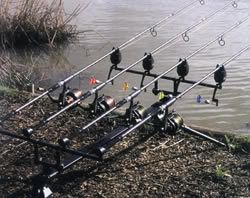 The alarms are adjustable for sensitivity, beep tone, and volume, so you can tell which rod has a bite. Plus, there is a light that comes on when a take is detected--the little light feature is very handy at night. 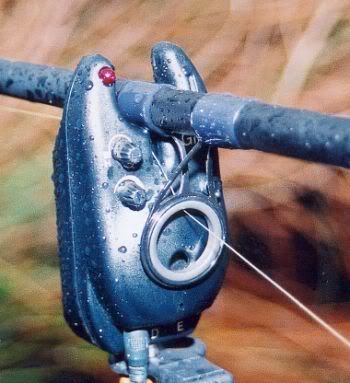 Reels have a "bait runner" feature, basically a second drag that lets line come off the reel under tension when the bail is closed. The tension can be adjusted, and the baitrunner is engaged with a lever in the back of the reel and disengaged when you start reeling. 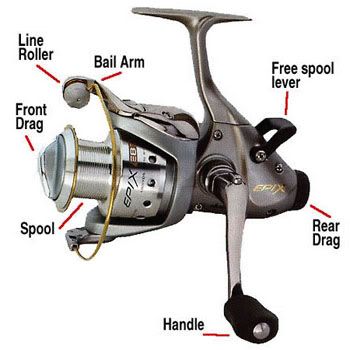  Rods are usually long (9-13 feet), with powerful butt sections for distance casting and soft tips for playing big fish up close without the hook pulling out. 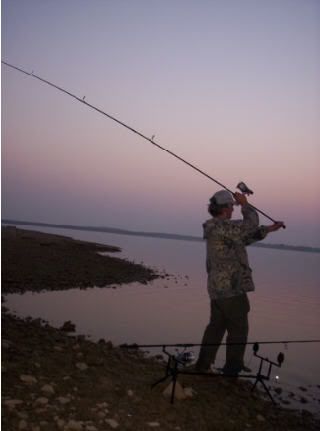 This is a "bolt rig": 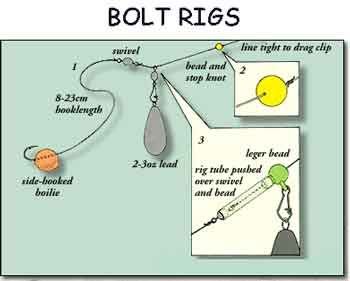 The hook is tied with a "hair rig": 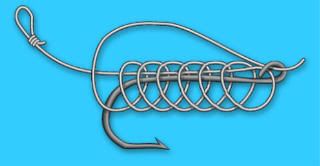 <<Table of Contents>> <<Table of Contents>>
Brett
|
|
 Re: Carp FAQ
[Re: Smile-n-Nod]
#3798025
08/10/09 04:33 PM Re: Carp FAQ
[Re: Smile-n-Nod]
#3798025
08/10/09 04:33 PM
|
Joined: Jul 2005
Posts: 5,857
Smile-n-Nod
 OP
OP
TFF Celebrity
|
OP

TFF Celebrity
Joined: Jul 2005
Posts: 5,857 |
<<Table of Contents>>MoCarp's EuroCarping 101 (2 of 4)A baiting needle is used to pierce a bait-�in this case a boilie--but corn or many other semi-hard baits can be used this way.  The back of the hair is drawn through the bait:  then the bait is snugged up on a stop: 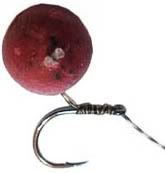 Some tools and examples: 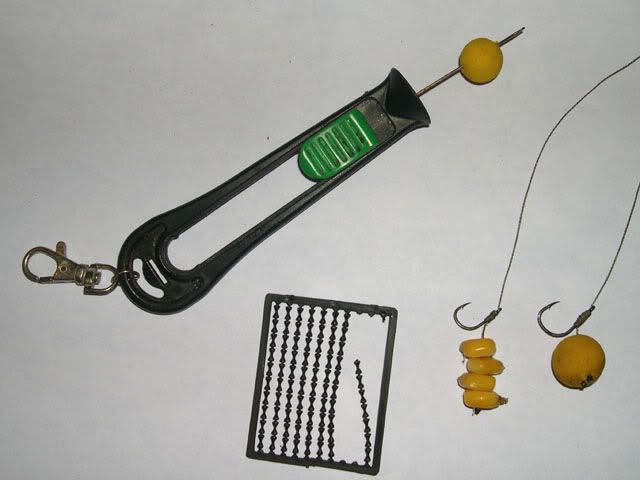 Fish can take the bait without feeling the hook before it's too late---also, the fish are less likely to be gut-hooked with this set up. The fish do not feel the hook until the bait part is swallowed; when they feel the hook, they try to expel it and are stung by the hook. The hair is tied so that the hook turns in as it is expelled; the fish �bolts off� and hits the fixed lead, driving the hook home!!! Zzzzzzzzzzzzzzzzzzzzzzzzzzzzzzzzzzz Fish on!  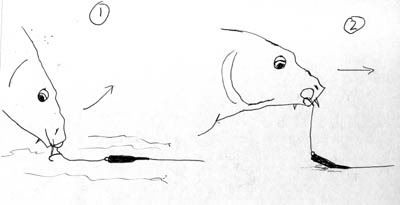 <<Table of Contents>> <<Table of Contents>>
Brett
|
|
 Re: Carp FAQ
[Re: Smile-n-Nod]
#3798027
08/10/09 04:34 PM Re: Carp FAQ
[Re: Smile-n-Nod]
#3798027
08/10/09 04:34 PM
|
Joined: Jul 2005
Posts: 5,857
Smile-n-Nod
 OP
OP
TFF Celebrity
|
OP

TFF Celebrity
Joined: Jul 2005
Posts: 5,857 |
<<Table of Contents>>MoCarp's EuroCarping 101 (4 of 4)With huge fish, a big net is a must. Light weight, these euro nets can be used with one hand. The net has no crossbar, just two arms that are usually at least 40" long. Fish slide over the barless lip of the net, and then must be lifted vertically, as the net was not designed to lift fish horizontal like traditional nets.    After netting, fish are usually placed on a padded mat, for three reasons-- 1) to protect the fish; 2) to calm the fish (they flip around less on a mat); 3) to weigh the fish (many mats double as a weighing sling; just loop the handle in the hook of the scale and subtract the weight of the mat--many times big fish are damaged when the hook of the scale is put in its gills) 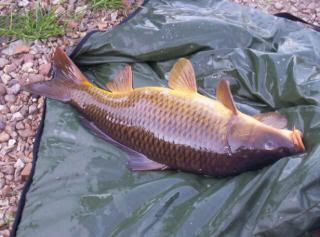 Chasing the biggest carp in the lake may take a few days, so in Europe they camp right on the water in fishing tents called bivvies. 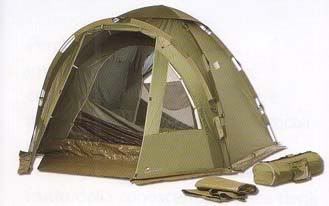 One of the backbones of euro-style fishing is chumming. Since you do not have the luxury of moving around looking for feeding fish, chumming is used to bring fish in and keep them feeding in the area. Here is a catapult: 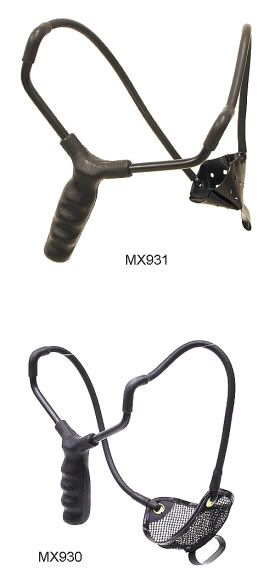 Spods are tied to the line and cast out. The nose floats and the bait falls out; better when the fish are at distance 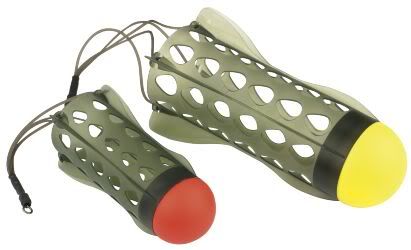 Remote control bait boat. Chum is placed in the center dropper hopper and piloted out to place the chum bed. 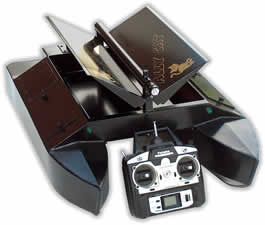 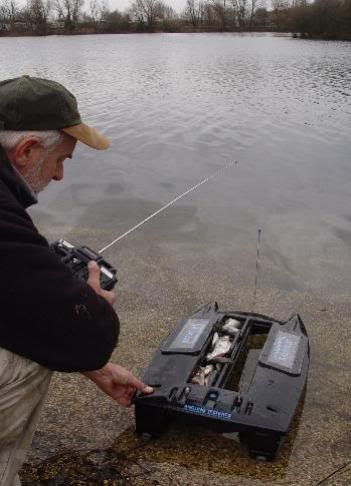 As you can see, the whole bank fishing thing is as sophisticated as you want to make it. Euro fishing offers a challenge to even the most hard core angler. Many anglers may look down their noses at carp. If you try it a few times, you will quickly get addicted to the powerful runs carp are known for. Few fish can rival even a 10-pound common carp for line-stripping run after line-stripping run. Just imagine the fight of a fish of 20 pounds! Eating smaller carp is an option; doing so may even help a lake produce bigger carp, but release the biggest ones to catch again. Many times you will re-catch the same big fish again and again over several years, usually a little bigger each time  So where to get this kind all this kind of gear? Lots of Euro stuff can be bought at Bass Pro, Cabelas, Big Carp Tackle, wackerbaits.com, and royalcarp.com. Quick fact: Common carp were stocked on purpose in the USA. They are not invasive escapees like portrayed by many news reports like the the bighead and-silver Asian carp so much in the news. But, beginning when Ulysses S Grant was president, common carp were imported from Germany to raise by the federal fisheries agencies and distributed to states in the late 1880s. The common carp is among the most widely distributed fish in America. It is a fierce fighter that is believed to live as long as 40 years. Most Fish and Game biologists consider common carp to be naturalized, much like honey bees are today. Growth rates of common carp are nowhere near what most average anglers have come to take as facts. In "The fishes of Missouri" by William L Pflieger, common carp growth rates in Missouri were studied: "Carp avg 6.5 inches in length at the end of their first year of life and achieve lengths of 11, 14.2, 16.7, and 18 inches in succeeding years. On the average, they weight one pound when 12 inches, 5 pounds when 21.5 inches, and 12 pounds when 27 inches long. Big fish are truly a rare resource." <<Table of Contents>>
Brett
|
|
 Re: Carp FAQ
[Re: Smile-n-Nod]
#3798327
08/10/09 05:50 PM Re: Carp FAQ
[Re: Smile-n-Nod]
#3798327
08/10/09 05:50 PM
|
Joined: Feb 2007
Posts: 10,481
Golden Ghost

TFF Guru
|

TFF Guru
Joined: Feb 2007
Posts: 10,481 |
Looks good!
I'm a big fan of "US Carp Prop Magazine."
I'd love to get a set for the C152 I fly. ROFL A little casual reading while the autopilot is on? No..... "US Carp Prop Magazine." It's "US Carp Pro Magazine."
|
|
 Re: Carp FAQ
[Re: Golden Ghost]
#3798568
08/10/09 06:32 PM Re: Carp FAQ
[Re: Golden Ghost]
#3798568
08/10/09 06:32 PM
|
Joined: Jul 2005
Posts: 5,857
Smile-n-Nod
 OP
OP
TFF Celebrity
|
OP

TFF Celebrity
Joined: Jul 2005
Posts: 5,857 |
Looks good!
I'm a big fan of "US Carp Prop Magazine."
I'd love to get a set for the C152 I fly. ROFL A little casual reading while the autopilot is on? No..... "US Carp Prop Magazine." It's "US Carp Pro Magazine." Ah, you're pointing a misspelling. Gotcha.
Brett
|
|
Moderated by banker-always fishing, chickenman, Derek 🐝, Duck_Hunter, Fish Killer, J-2, Jacob, Jons3825, JustWingem, Nocona Brian, Toon-Troller, Uncle Zeek, Weekender1
|

